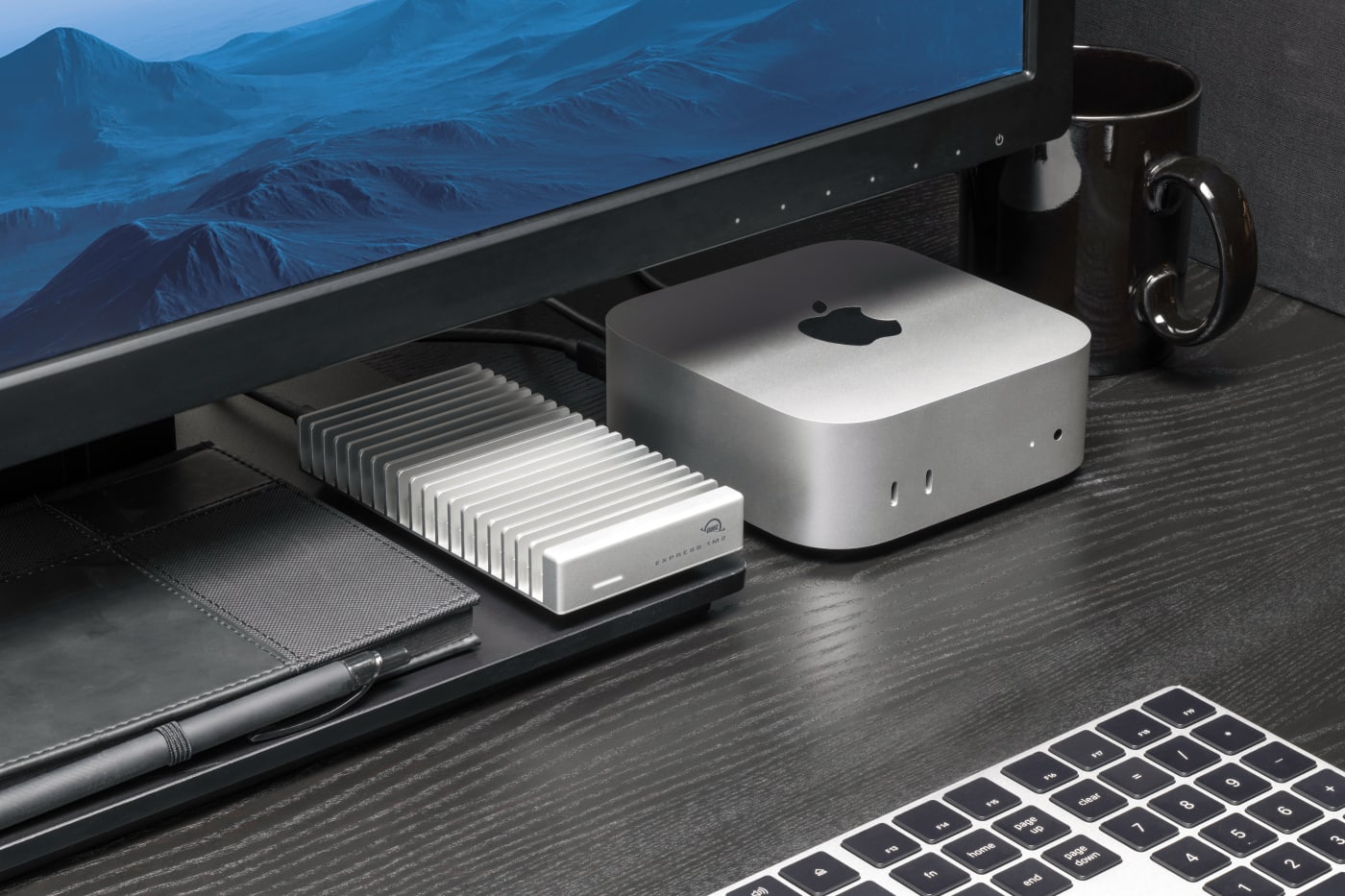Can USB4 v2 and Thunderbolt 5 Enclosures Deliver PCIe Gen5 Speeds?
Yes, you can put a state-of-the-art PCIe Gen5 NVMe inside an enclosure like the OWC Express 1M2 80G. But does it deliver the full benefit of PCIe Gen5? Real numbers, clear guidance, no hype.
Wayne Grayson • Oct 06, 2025

With double the bandwidth (80 Gb/s) over the previous generation, USB4 v2 and Thunderbolt 5 have pushed external SSD performance forward in a major way.
Our new OWC Express 1M2 80G enclosure takes full advantage of these standards, delivering real-world peak speeds of more than 6,000 MB/s-almost twice the throughput of the prior Express 1M2.
But Express 1M2 80G also features a fanless, heat-dissipating, DIY-friendly design, allowing you to order it as a 0TB enclosure and install the M.2 NMMe blade of your choice.
All of this makes the Express 1M2 80G a seriously capable and seriously versatile SSD enclosure for enthusiasts and professionals alike. It's an ideal solution for everything from serving as a high-bitrate video editing drive, to storing massive photo and game libraries, storing your Home folder in macOS as a quick upgrade over internal storage, or pulling scratch-disk duties.
Plus, the Express 1M2 80G comes ready to support PCIe Gen5 NVMe blades. That means you can install a Gen5 blade today, or upgrade to one in the future. However, there are some things to know before you install a PCIe Gen5 NVMe in the Express 1M2 80G and that's what we're going to cover in the rest of this post.
While a PCIe Gen5 NVMe SSD is compatible with an enclosure like the OWC Express 1M2 80G, physics is here to drizzle on the parade. While the blade itself is Gen5, USB4 v2 and Thunderbolt 5 enclosures are built to PCIe Gen4 spec.
That means the real-world speed of a drive installed in one of these enclosures will top out around 6-7 GB/s.
Why some confusion exists
Thunderbolt 5 is an overlying technology that is inclusive of USB4 v2, DisplayPort 2.1, and PCIe Gen4 standards. These standards provide a total bi-directional data bandwidth of 80 Gb/s (gigabits per second) over Thunderbolt 5 and USB4 v2 and add a 120 Gb/s "Bandwidth Boost" mode for displays.
However, PCIe storage connections like the Express 1M2 80G do not have access to the full 80 Gb/s the spec supports. The spec limits these standards' pipe for storage to 64 gigabits (Gb/s) or 8 gigabytes (GB/s) per second.
Meanwhile, PCIe Gen5 drives support even more bandwidth than Thunderbolt 5/USB4 v2. Gen5 drives can move data at speeds around 15.8 gigabytes per second (GB/s) in ideal conditions. But they achieve these speeds only when installed internally on a PCIe Gen5 capable motherboard and/or interface.
When connecting a PCIe Gen5 NVMe via an external enclosure—even if it's a super-fast external enclosure with USB4 v2 or Thunderbolt 5 support—speed is limited to the spec of the port standard.
While many people may see a PCIe Gen5 NVMe and get excited about getting all of that Gen5 speed when installing it into an external enclosure, external I/O standards prioritize universal connectivity, power optimization, sustained performance, and display bandwidth alongside storage.
In other words, because the enclosure is Gen4, the Gen5 blade installed inside will perform like a Gen4 blade. Ultimately, performance will be at the levels any given blade is able to peak and/or sustain within the limits that both Gen4 PCIe enable and within the capabilities of Thunderbolt 5 / USB4v2 interface.
So is a PCIe Gen5 SSD "compatible" with Express 1M2 80G or not?
Yes. Express 1M2 80G supports PCIe Gen3/Gen4/Gen5 M.2 NVMe drives. On an 80 Gb/s USB4/Thunderbolt 5 host, these drive/enclosure combos reliably deliver more than 6000 MB/s peak real-world transfers (and steps down cleanly on 40 Gb/s hosts where the enclosure and drive within then operate within the limits of Thunderbolt 4/USB4 40Gb/s operation where data rates are still supported at impressive over 3800MB/s capability).
But when you stuff a highly capable blade into an external enclosure there are consequences. The only practical caveat beyond not getting the full speed a Gen5 blade is capable of when using some Gen5 sticks externally are complications with power in a bus-powered enclosure. That's why we recommend choosing Gen5 SSDs that average 11 W during sustained transfers.
While more recent Gen 5 M.2 options do operate within this level and and comply with PCIe power draw specifications, many earlier Gen5 options from 2024 and early 2025 have tended to go well over specification and require more power than spec and thus more than what bus-power can also provide. Such drives are simply not suitable for bus power and also may have thermal complications in addition to operational complications when the power they require is not available on the bus to draw. Bus power provides a maximum of 15 Watts of power to a device for all its needs. We have measured the noted earlier model Gen5 M.2 options at substantial periods of draw exceeding 20 Watts, which far exceeds all spec limits. Such drives are simply not supportable in a bus-powered enclosure.
The protocol reality in plain English
Plugging a Gen5 NVMe into a USB4 v2/Thunderbolt 5 enclosure doesn't magically unlock 15+ GB/s transfers.
Why? Because the PCIe connection tunneled through this port is Gen4-class, capped at about 8 GB/s. After overhead, the real-world numbers land in the 6-7 GB/s range.
By comparison, an internal motherboard PCIe Gen5 x4 slot can push around 15.8 GB/s under ideal conditions.
So, while power-spec-compliant Gen5 drives are fully compatible with Thunderbolt 5/USB4 v2 enclosures, performance is limited by the spec of your host port and cable, not necessarily the SSD.
What you should expect (and how to get the best performance possible with a Gen5 blade)
When pairing Express 1M2 80G with a PCIe Gen5 NVMe, you'll enjoy Gen5 controller characteristics (latency behavior, firmware, large SLC caches, etc.), but throughput is capped by the link:
- Use an 80 Gb/s-capable host (USB4 v2 or Thunderbolt 5). That's how you reach the >6 GB/s class speeds. On 40 Gb/s hosts (USB4/TB4), expect ~3-4 GB/s, and ~2.8 GB/s on many TB3 Macs.
- Pick the right drive. For bus-powered use, go with efficient Gen4 or. 11 W Gen5 models to minimize throttling in sustained writes.
FAQ
Q: "Is Thunderbolt 5/USB4 v2 compatible with PCIe Gen5?"
A: Yes. However, because Thunderbolt 5 and USB4 v2 are based on PCIe Gen4 for the tunneled PCIe link, performance over the cable is Gen4-class even with a Gen5 SSD.
Q:"Why does my external SSD's speed drop when plugged into my dock or hub?
A: For an external drive to operate at full speed, each device in the chain the series of connected devices that is connected to a host device must reach USB4 v2/Thunderbolt 5 specs. For example, if you plug the 1M2 80G into a bus-powered USB3 hub, your device will likely drop off the bus due to not enough power being delivered. If you plug the 1M2 80G into a Thunderbolt 4 hub, even though the enclosure is capable of 6-7 GB/s speed, it will operate at the ceiling of Thunderbolt 4 which is 3-4 GB/s speeds. To achieve maximum performance, the 1M2 80G must be plugged into another USB4 v2/Thunderbolt 5 device that is itself connected to a host device with USB4 v2/Thunderbolt 5 support.
Q: "Why doesn't my Gen5 SSD do 12-14 GB/s externally?"
A: That kind of performance requires native PCIe Gen5 x4 on the motherboard. Over Thunderbolt 5/USB4 v2, the PCIe pipe is 64 Gb/s, which translates to about 6-7 GB/s of real-world sustained performance after bus overhead in typical real-world operation.
Q: "Is USB4 v2 really different from Thunderbolt 5?"
A: They're tightly aligned. USB4 v2 defines the 80 Gb/s physical layer and protocol updates; Thunderbolt 5 layers in certification and feature guarantees (e.g., display budgets, power delivery) and is built on USB4 v2 + DisplayPort 2.1 + PCIe Gen4.
Q: Why might OWC real-world numbers be lower than what others claim and even what OWC's own customers report with OWC devices?
A: We work very hard to supply honest data and we seek to provide real-world, realistically attainable specifications. We err to the side of 'real world' vs. seeking to use artificial results or corner case peaks to make "speeds and feeds" show cases. It is important to us that you have experiences in the real world with all our solutions that, at the very least, are in alignment with the information we share. Your success in all endeavors that you trust OWC solutions with is of the highest importance to all of us at OWC.
Specs, pricing & availability
The OWC Express 1M2 is available now starting at just $219 for a 0TB enclosure, with pre-built configurations up to 8TB. The enclosure supports NVMe M.2 2280/2242 SSDs with peak real-world performance of more than 6,000 MB/s.
Learn more/buy Express 1M2 80G on the OWC site.
Other topics you might like
The OWC Atlas Ultra CFexpress Card is Officially Recommended for the Blackmagic PYXIS 12K
Updated on Oct 9, 2025
OWC Wins Two Best of Show Awards at IBC 2025
Updated on Sep 17, 2025
The Most Versatile External DIY SSD, Now Even Faster: Meet the OWC Express 1M2 80G
Updated on Aug 19, 2025
 USA + International
USA + International OWC Canda
OWC Canda OWC Europe
OWC Europe


